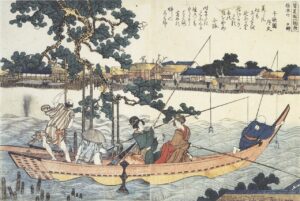Flirting Squid with Colors
One of the squid species, Swordtip squid, is especially favored by Japanese anglers, because it is fun to fish them and great to eat. It is said that there are more than 30 major species of squid in Japan, and this Swordip squid is considered to be one of the best species for Japanese cuisine.
This article shows you about one of the traditional ways to catch this squid. With some information about the species and the origins of this fishing.
Species
Swordtip squid (Uroteuthis edulis) is named as Kensaki-ika as a Japanese species name, but there are many names in each region. In the Kanto region it is called Aka-ika, which literally means red-squid or Maru-ika, meaning round-squid, in the Chugoku region Shiro-ika, meaning white-squid or Ma-ika, meaning real-squid. This diversity of its names is probably coming from the difference in colors of squid by region, or the ways they catch or treat squids are different and it gives people a different impression on this species.
This squid species is distributed in Indo-Pacific regions, where the climate types are tropical or temperate. It lives in the north of Australia, southeast Asian countries, China, and Japan. In Japan, as it likes the warmer temperature, it is more popular in central and to western Japan.
It spawns from spring to autumn, in the inshore area of the depth of 20 to 40 meters. In winter, it goes down to deeper areas of 60 to 100 meters. Though it is a popular species, the details of behavior is not clarified. The best season for fishing is spring to autumn.
It is carnivorous and feeds on fish mainly. Within one year of its life cycle, it grows up to about 35 cm in trunk length.
Fishing
The traditional boat fishing style and lure fishing (squid jig) are two popular ways of Swordtip squid fishing. This article will be showing the traditional way of catching it.
Firstly the tackles and rigs. If you have ever visited Japanese fishing shops, you may have noticed there are colorful pre-assembled rigs like below.
This is the rig for this squid. This rig would be sent down to 20 to 40 meters depth, in high season, and the total tackle looks like the one in the picture below.
It uses the special rod of 1.8 to 2.4 meters, weight ranges from 20 to 60 gou (75 to 200 grams.) The main line is a braided line of 0.6 to 2 gou (0.12 mm to 0.20 mm thickness) of more than 100m length. The small multiplier or electric reels are used to hold the main line. The details of the necessary rigs vary depending on the area or the boat captain’s preference.
There are two types in the rigs. One is the paternoster type with multiple branches. Each branch has a small lure. Another is the one, direct connected type, in which lures are connected straightly in line to the sinker.
Branched lures can move freely swinging along the leader. It is better in presentation for the squid and it is less likely to lose a squid unhooked. On the contrary, direct connected lures can transfer the bite or the touch and you can give the direct hooking, while the squid can easily be unhooked when treated badly.
These lures are called Sutte in Japanese. There are many lures available in the market. Sizes vary from 35 to 55 mm. They are made from plastic, wrapping cloth and a hook. There are different types of buoyancy, and some have double hooks, bare plastic or with wrapping, etc. Of course, there are various colors available.
The fishing procedure is like this. Step 1 is to drop your rigs to the notified depth as quickly as possible. When the fishing boat is at the right spot, the captain tells everyone to drop their rigs at a certain depth or at the bottom. It means that he found the school of squid below their boat. The faster you can send your rig at the depth, the more likely you get the first bite. At the beginning, the school of squid is pure enough to be attracted by your lure easily, but after a while these squids become hard to get flirted with by lures. If you really want to be the first, there is a sinker to drop in the water faster.
After your rig is at the targeted depth, you try to control the line tensioned properly. Even immediately after it reaches there, squids may be on hook, therefore you need to pay attention to the change of line tension or awkward line slack.
If there is nothing happening, then you jerk the rod once and wait for a while. Then you wind up for about 1 meter and wait for the next reaction from the water. You repeat this procedure to bring up your rigs from 3 to 5 meters above the target depth or bottom, then you release the line again to let it down to the targeted depth.
When you feel that your branches in the rig get enough squids, then you wind up your rig slowly and steadily. As the hooks have no barbs, if your rig plays up and down too much, then you can easily lose your squids.
You can see the entire process of fishing in this video.
From this video, you noticed that the angler shakes his rod several times. It is said that the quick and sudden moves of lures can attract squid. Therefore, some anglers prefer to shake them. For this purpose, the branch leader length tends to be very short. And the direct connected lures moves directly with the move of the rod.
The bite is very subtle. To detect it, the rod tip is very popular while the action is very fast. With the bite the tip moves either up or down slightly. When you detect the bite, you hook the fish with raising your rod.
In this fishing, when you are in the middle of the big school of Swordtip squid, you have to repeat the process as quickly as possible. This makes a big difference in the result.
Origin of squid lure
According to the record of fishing tackles published in 1916 (archive link,) some regions of Japan had the rigs for squid fishing like the images below.
The first one is with the hand line, a kind of balancer rig. It uses the balancer, with the integrated lead sinker. In the place of the modern squid lures, it has the stick with the hook. And the stick is wrapped with squid meat which is fixed with a cotton thread.
In the image below, it uses the rod with a kind of jigs. As the shape of the rod looks like the horns of an animal, it was called a horn rod.
This type of squid jig is made of the stick of brass. And the meat of squid, the animal meat, or the dried meat were wrapped around the stick.
The way of fishing with these rigs was very similar to the modern one. Fishermen lift and fall these jigs and try to attract squids. The actions of fishermen with the above horn rod looked like they were beating drums, and this fishing was called “drum fishing.” It implies that the lift and fall movement was very rapid, and it might even look similar to the shaking method of modern fishing.
Interestingly, this book explains that these styles of rigs already existed from the time of the Edo period.
Squid has been one of the popular fish in Japanese cuisine. At the same time, probably, fishermen have been enjoying catching squid for a long time.

